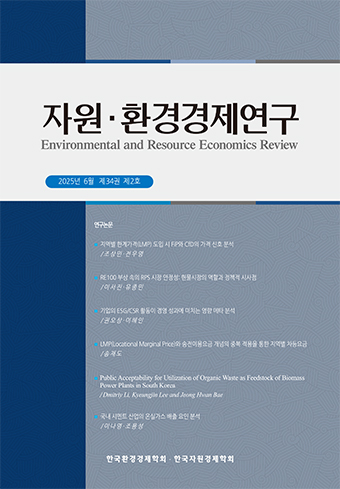Research Paper
Abstract
References
Information
Bioplastics are attracting attention as a substitute for conventional petroleum-based plastics because they are carbon neutral and can be biodegradable. This study estimated economic and environmental impact of regulating the petroleum-based plastics industry and fostering the bioplastics industry using a Recursive Dynamic CGE Model of the Korean Economy. Results show that the regulation of the conventional plastics industry exhibits a positive environmental impact by reducing greenhouse gases and plastic waste and a negative economic impact with a decrease in GDP. Meanwhile, fostering the bioplastics industry with regulation on conventional plastics industry has similar levels of greenhouse gas and waste reduction effects when there is only regulation on the conventional plastics industry. It is also shown that expanding the production of bioplastics industry offsets existing economic losses as a form of increased GDP. If petroleum-based plastics are replaced through the expansion of bioplastics production, it can contribute to the decoupling of greenhouse gas emissions and plastic waste from economic growth.
바이오플라스틱은 탄소중립적이며 생분해가 가능하다는 점에서 기존 플라스틱의 대체재로 주목받고 있다. 이 연구는 일국 축차동태 연산가능일반균형 모형을 사용하여 석유 기반 플라스틱산업 규제와 바이오플라스틱산업 육성에 따른 경제적 환경적 파급효과를 추정하였다. 분석결과, 플라스틱산업 규제 시 온실가스 감축과 폐기물 감소 효과가 나타나 긍정적인 환경적 파급효과가 발생한 반면, GDP는 감소하여 경제적으로는 부정적인 파급효과를 확인할 수 있었다. 한편 플라스틱산업 규제와 바이오플라스틱산업 육성이 동시에 이루어지는 경우, 플라스틱산업 규제만 시행하는 시나리오와 비교하여 유사한 수준의 온실가스 감축과 폐기물 감소효과가 발생했으나 바이오플라스틱산업 생산 확대가 기존의 경제적 손실을 상쇄시켜 GDP를 증가시키는 것으로 나타났다. 따라서 바이오플라스틱 생산 확대를 통해 석유 기반 플라스틱을 대체해 나간다면 온실가스 배출 및 플라스틱 폐기물 발생과 같은 환경문제를 개선하면서 경제성장을 가능하게 하는 탈동조화(decoupling)에 기여할 수 있을 것으로 판단한다.
- 강상인‧김재준, “축차 동태형 환경경제 통합모형 연구”, 한국환경정책평가연구원 기본연구보고서, 2007.
- 관계부처 합동, 「2030년 국가 온실가스 감축목표 달성을 위한 기본 로드맵 수정안」, 2018.
- 관계부처 합동, 「한국판 뉴딜 종합계획」, 2020a.
- 관계부처 합동, 「대한민국 2050 탄소중립 전략」, 2020b.
- 관계부처 합동, 「화이트바이오 산업 활성화 전략」, 2020c.
- 김성태‧이상돈‧조경엽‧임병인, “한국의 산업별 생산의 대체탄력성 추정”, 「응용경제」, 제13권 제3호, 2011, pp. 99~122.
- 김홍배, 『도시 및 지역경제 분석론』, 기문당, 2009.
- 남장근‧최윤희‧정혜린‧정무섭, “신성장동력으로서의 바이오화학산업의 정책과제 - 바이오플라스틱을 중심으로”, 산업연구원, 2014.
- 산업연구원, “2021년 경제·산업 전망”, 「I-KIET 산업경제이슈」, 제100호, 2020.
- 산업통상자원부, 「2015년 기준 국내 바이오산업 실태조사」, 2017.
- 심우석‧남장근, “탈석유화학산업 바이오플라스틱의 창조적 역할”, 산업연구원, 2013.
- 에너지경제연구원, 「2015 에너지 통계연보」, 2016.
- 온실가스종합정보센터, 「국가 온실가스 증감요인 분해분석 연구」, 2016.
- 온실가스종합정보센터, 「2017 국가 온실가스 인벤토리 보고서」, 2017.
- 유거송‧박철환‧박경문, “바이오경제로의 이행을 위한 화이트바이오 산업 육성 정책 제언”, 한국과학기술기획평가원, 「 ISSUE WEEKLY」, 6(212), 2017, pp. 1~21.
- 이신엽‧안재우‧황형진‧이선복, “한국의 해조류 바이오매스자원 현황”, 「KSBB Journal (한국생물공학회)」, 제 26권 제 4호, 2011, pp. 267~276.
- 통계청, 「장래인구특별추계: 2017~2067년」, 2019.
- 한국개발연구원, “글로벌 위기 10년의 한국경제와 새로운 성장 어젠다”, 2018.
- 한국생명공학연구원, 「바이오화학산업 길라잡이」, 2016.
- 한국석유화학협회, 「석유화학산업의 이해, 석유화학으로 만드는 세상」, 2015.
- 한국석유화학협회[웹사이트], http://www.kpia.or.kr/index.php/main
- 한국에너지공단, 「산업부문 에너지사용 및 온실가스 배출량 통계」, 2016.
- 한국은행[웹사이트], 경제통계시스템, http://ecos.bok.or.kr/
- 환경부, “불법 폐기물 원천 차단을 위한 중간처리업체 일제 조사”, 2020.9.16. 보도자료, 2020a.
- 환경부,「생활폐기물 탈 플라스틱 대책」, 2020b.
- EC, “Review of the 2012 european bioeconomy strategy,” 2017.
- Euromap, Plastics Resin Production and Consumption in 63 Countries Worldwide, 2016.
- European Bioplastics, https://www.european-bioplastics.org/market/, 2021.
- Haddad, S., and N, Escobar, “Economic and environmental implications of a target for bioplastics consumption : A CGE analysis Economic and environmental implications of a target for bioplastics consumption,” International Association of Agricultural Economists, 2018.
- Hosoe, N., K. Gasawa, and H. Hashimoto, Textbook of Computable General Equilibrium Modeling: Programming and Simulations, 2nd Edition. University of Tokyo Press, Tokyo, Japan, 2015.
- Hosoe, N., K. Gasawa, and H. Hashimoto, Textbook of Computable General Equilibrium Modelling: Programming and Simulations, Palgrave Macmillan, Hampshire, 2010.10.1057/9780230281653
- Hurley, R., J. Woodward, and J. J. Rothwell, “Microplastic contamination of river beds significantly reduced by catchment-wide flooding,” Nature Geoscience, Vol. 11, No. 4, 2018, pp. 251~257.10.1038/s41561-018-0080-1
- IEA, The Future of Petrochemicals Towards more sustainable plastics and fertilisers, 2018.
- Lee, D., “Bio-based economies in Asia : Economic analysis of development of bio-based industry in China, India,” International Journal of Hydrogen Energy, Vol. 41, No. 7, 2016, pp. 4333~4346.10.1016/j.ijhydene.2015.10.048
- Nowicky, P., M. van Leeuwen, H. Bos, L. Chant, K. Molenveld, and A. Tabeau, Influence of the biobased economy on agricultural markets - Preparation of a modelling approach (Issue January), 2010.
- OECD, “Sustainable Development: Indicators to measure decoupling of environmental pressure from economic growth,” OECD Report, 1, 2002.
- Shin, “The effects of an environmental tax on trade : a cge approacth to the korean case,” the Korean Economic Review, Vol. 11, 1995, pp. 5~15.
- Publisher :Environmental and Resource Economics Review
- Publisher(Ko) :자원 · 환경경제연구
- Journal Title :자원·환경경제연구
- Journal Title(Ko) :Environmental and Resource Economics Review
- Volume : 30
- No :2
- Pages :269-297
- DOI :https://doi.org/10.15266/KEREA.2021.30.2.269



 자원·환경경제연구
자원·환경경제연구






